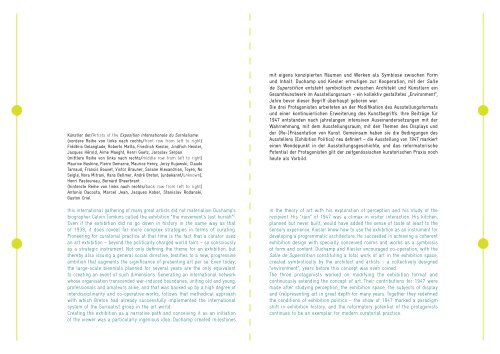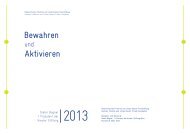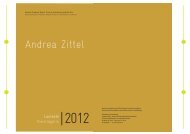Download - Ãsterreichische Friedrich und Lillian Kiesler Privatstiftung
Download - Ãsterreichische Friedrich und Lillian Kiesler Privatstiftung
Download - Ãsterreichische Friedrich und Lillian Kiesler Privatstiftung
Sie wollen auch ein ePaper? Erhöhen Sie die Reichweite Ihrer Titel.
YUMPU macht aus Druck-PDFs automatisch weboptimierte ePaper, die Google liebt.
Künstler der/Artists of the Exposition Internationale du Surréalisme:<br />
(vordere Reihe von links nach rechts/front row from left to right)<br />
Frédéric Delanglade, Roberto Matta, <strong>Friedrich</strong> <strong>Kiesler</strong>, Jindřich Heisler,<br />
Jacques Hérold, Aime Maeght, Henri Goetz, Jaroslav Serpan<br />
(mittlere Reihe von links nach rechts/middle row from left to right)<br />
Maurice Baskine, Pierre Demarne, Maurice Henry, Jerzy Kujawski, Claude<br />
Tarnaud, Francis Bouvet, Victor Brauner, Sarane Alexandrian, Toyen, No<br />
Seigle, Nora Mitrani, Hans Bellmer, André Breton, [unbekannt/unknown],<br />
Henri Pastoureau, Bernard Gheerbrant<br />
(hinterste Reihe von links nach rechts/back row from left to right)<br />
Antonio Dacosta, Marcel Jean, Jacques Kober, Stanislav Rodanski,<br />
Gaston Criel<br />
this international gathering of many great artists did not materialise: Duchamp’s<br />
biographer Calvin Tomkins called the exhibition “the movement’s last hurrah” 6 .<br />
Even if the exhibition did no go down in history in the same way as that<br />
of 1938, it does reveal far more complex strategies in terms of curating.<br />
Pioneering for curatorial practice at that time is the fact that a curator used<br />
an art exhibition – beyond the politically charged world fairs – so consciously<br />
as a strategic instrument. Not only defining the theme for an exhibition, but<br />
thereby also issuing a general social directive, testifies to a new, progressive<br />
ambition that augments the significance of presenting art per se. Even today,<br />
the large-scale biennials planned for several years are the only equivalent<br />
to creating an event of such dimensions. Generating an international network<br />
whose organisation transcended war-induced bo<strong>und</strong>aries, uniting old and young,<br />
professionals and amateurs alike, and that was backed up by a high degree of<br />
interdisciplinarity and co-operative works, follows that methodical approach<br />
with which Breton had already successfully implemented the international<br />
system of the Surrealist group in the art world.<br />
Creating the exhibition as a narrative path and conceiving it as an initiation<br />
of the viewer was a particularly ingenious idea. Duchamp created milestones<br />
mit eigens konzipierten Räumen <strong>und</strong> Werken als Symbiose zwischen Form<br />
<strong>und</strong> Inhalt. Duchamp <strong>und</strong> <strong>Kiesler</strong> ermutigen zur Kooperation, mit der Salle<br />
de Superstition entsteht symbiotisch zwischen Architekt <strong>und</strong> Künstlern ein<br />
Gesamtkunstwerk im Ausstellungsraum – ein kollektiv gestaltetes „Environment“,<br />
Jahre bevor dieser Begriff überhaupt geboren war.<br />
Die drei Protagonisten arbeiteten an der Modifikation des Ausstellungsformats<br />
<strong>und</strong> einer kontinuierlichen Erweiterung des Kunstbegriffs. Ihre Beiträge für<br />
1947 entstanden nach jahrelangen intensiven Auseinandersetzungen mit der<br />
Wahrnehmung, mit dem Ausstellungsraum, mit den Themen des Displays <strong>und</strong><br />
der (Re-)Präsentation von Kunst. Gemeinsam haben sie die Bedingungen des<br />
Ausstellens (Exhibition Politics) neu definiert – die Ausstellung von 1947 markiert<br />
einen Wendepunkt in der Ausstellungsgeschichte, <strong>und</strong> das reformatorische<br />
Potential der Protagonisten gilt der zeitgenössischen kuratorischen Praxis noch<br />
heute als Vorbild.<br />
in the theory of art with his exploration of perception and his study of the<br />
recipient. His “rain” of 1947 was a climax in visitor interaction. His kitchen,<br />
planned but never built, would have added the sense of taste at least to the<br />
sensory experience. <strong>Kiesler</strong> knew how to use the exhibition as an instrument for<br />
developing a programmatic architecture. He succeeded in achieving a coherent<br />
exhibition design with specially conceived rooms and works as a symbiosis<br />
of form and content. Duchamp and <strong>Kiesler</strong> encouraged co-operation, with the<br />
Salle de Superstition constituting a total work of art in the exhibition space,<br />
created symbiotically by the architect and artists – a collectively designed<br />
“environment”, years before this concept was even coined.<br />
The three protagonists worked on modifying the exhibition format and<br />
continuously extending the concept of art. Their contributions for 1947 were<br />
made after studying perception, the exhibition space, the subjects of display<br />
and (re)presenting art in great depth for many years. Together they redefined<br />
the conditions of exhibition politics – the show of 1947 marked a paradigm<br />
shift in exhibition history, and the reformatory potential of the protagonists<br />
continues to be an exemplar for modern curatorial practice.








